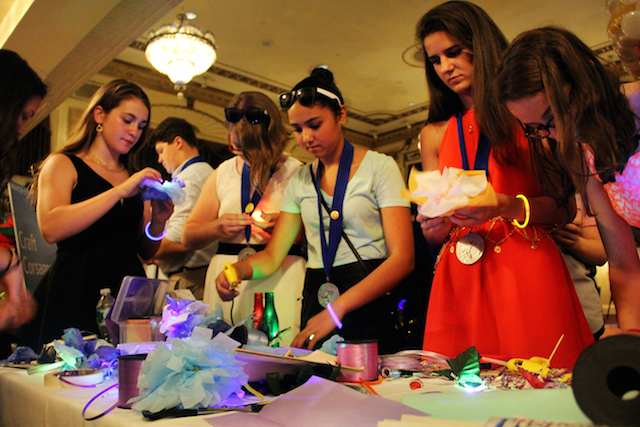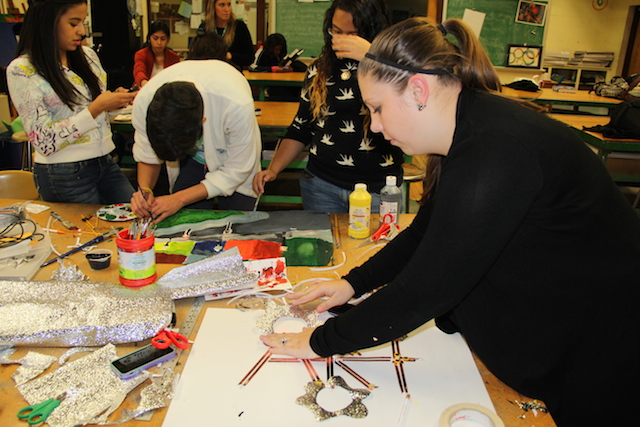Your end users could be your best product designers.
By Nicole Messier (CEO & Co-founder, blink blink)
As creative technologists, my co-founder and I always wished there were more women in the field of technology. We met at an event before graduate school, and quickly planned to dedicate our graduate studies at Parsons School of Design to creating opportunities for girls to explore technology creatively. We had the lofty hopes of getting girls all over the world excited about science, technology, engineering, and mathematics (STEM) at an early age.
When classes began, we met an assortment of women that were engineering incredibly beautiful art and fashion pieces with nontraditional technology and electronic materials. Instead of wires and breadboards, they were using “eTextiles” such as conductive thread, conductive fabrics and sewable electronics. Their pieces were stunning and required a great deal of technical engineering.
Joselyn and I both had the same thought: We wish we had come across this type of creative technology when we were younger! We pictured all the ways we would have enjoyed adding lights and electronics to our DIY arts, crafts and fashion projects.
That’s how blink blink, our graduate thesis-turned-startup started. Our creative circuit kits bridge the gap between tech engineering and arts, crafts and fashion. We wanted to design the ultimate DIY eTextile experience for teenage girls, but there was one problem — we were no longer teenagers ourselves.
For girls to feel truly welcome to explore our creative circuit kits, we decided we needed to start co-designing our kits with them. We worked specifically with high school girls because we needed their feedback at every stage of our design. But you can use our same process to design in tandem with your end-users.
 1. Hang Out With Your Users
1. Hang Out With Your Users
What if you truly got to know your users by simply hanging out with them? There is a difference between getting to know your user by user testing and a more informal hangout session. The latter is much more rewarding for both of you, and ultimately your product will be better if you make a real effort to get to know your end users.
There are a variety of ways you can do this. As part of blink blink’s co-design process, we set up informal creative circuit workshops where girls would come into the workshop and make whatever their hearts desired. During the workshops, we would talk about everything from their work to their weekend plans. These workshops gave us the opportunity to observe what girls wanted to create, what they did in their spare time, and how they interacted with our materials.
Your turn: Find a space where you can spend time with your users and learn more about them. Host workshops, meetups or simply meeting them where they’re at. We know of an amazing group called Sunset Spark that hosts pop-up maker spaces in laundromats because that’s where their audience is in their spare time. Try to make a concerted effort to make sure your engagement benefits your users as well.
2. Offer Different Feedback Avenues
Questionnaires and interviews are awesome, but they’re not loved by all. There are different ways to receive user feedback.
During blink blink workshops, we provide girls different options for feedback. We set up conversation circles so girls can provide feedback on our kits, project tutorial ideas and vocalize their discontent about aspects of the experience. For those who are quieter, we give them a blank piece of paper and encourage them to write or draw their feedback. We always get more out of informal types of feedback compared to formal questionnaires or interviews.
Your turn: Think of different avenues to brainstorm ideas; conversations, drawing and sticky notes are just a few. Take those and use them as ways for your user to give you feedback.
3. Listen, But Block Out the Noise
When you’re designing something for girls, everyone has an opinion on what not to do.
- “Don’t make it too girly.”
- “Don’t make it pink.”
- “Girls like X.”
We always listen to feedback, but we don’t always agree.
When you’re designing a product, you receive a lot of opinions from people you interact with. Often, they aren’t coming from your end user. Learn how to know what’s good advice and what is not — our rule of thumb is to typically stick to what our users say they want or what we observe.
If we didn’t know how to sort the useful feedback from the not-useful, our brand and product would have suffered; the blink blink color identity would be safe (read: boring), and our branding would not be the fun, spunky and crafty aesthetic that girls have helped us create.
4. Iterate on Ideas Together!
Some of your ideas and designs will be bad. Some of our ideas at blink blink were bad — like our first version of the blink blink Circuit Booklet, which attempted to talk students through building circuits instead of just showing them. (Luckily, girls told us right away to fix our ‘sucky’ tutorial).
Your turn: During your interactions with your users, spend time iterating ideas together. Let them be part of your team. Speed-iterating through ideas with your user is a fun way to explore together. Most of the ideas won’t stick, but you’ll find a few gems that are worth pursuing.
5. Be Flexible and Open to Exploration
We all have a workflow. Ours often syncs with our design process. When you’re co-designing with your users, you’ll have to jump ship from your process sometimes.
During a blink blink workshop, we intended to explore paper circuits; however, our workshop plans were thrown out the window when girls started creating sculptures with the paper circuit materials. We were blown away — what they were creating was way more imaginative than our plan, so we decided to just go with it.
Your turn: Be open to spontaneous exploration. You and your users may come up with your best ideas together.
Co-designing your product is the best way to get to know your user and build a product that is designed to truly meet their needs. Working with your users, in an intentional and empathetic way is rewarding for you, your team, and your users as well.
About blink blink: blink blink Creative Circuit Kits provide all the tools to engineer DIY arts, crafts and fashion projects with circuits and electronics, designed with empathy for girls ages 8+. Pre-order a blink blink kit for a girl you know!

 1. Hang Out With Your Users
1. Hang Out With Your Users